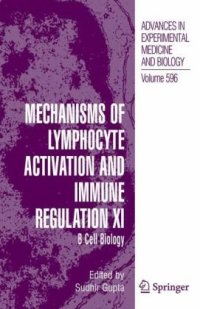
Ebook: Mechanisms of Lymphocyte Activation and Immune Regulation XI: B Cell Biology
Author: Cornelis Murre (auth.) Sudhir Gupta Frederick Alt Max Cooper Fritz Melchers Klaus Rajewsky (eds.)
- Tags: Immunology, Infectious Diseases, Microbiology, Virology, Pharmacology/Toxicology
- Series: Advances in Experimental Medicine and Biology 596
- Year: 2007
- Publisher: Springer US
- Edition: 1
- Language: English
- pdf
In recent years, major developments have been made in understanding various genetic and epigenetic regulatory processes that are critical for the generation of B cell repertoires. These include the role of chromatin regulation and nuclear organization in understating the IgH gene regulation. A role and mechanism of DNA repair proteins in somatic hypermutation has been elucidated. Genetic mutation studies have been instrumental in providing insight into some of the mechanisms involved in targeting CSR to various switch DNA regions located upstream of C region genes, especially a role of AID motifs, transcription, and R-loops. Recent studies support a dominant role of receptor editing in central B cell tolerance and signaling pathways that regulate receptor editing in self-reactive and non-self-reactive immature B cells. These were some of the topics of discussion at the 11th International Conference on B cell Biology. These proceedings highlight recent developments in lymphocyte development, Ig gene rearrangements and somatic hypermutation, chromatin structure modification, B lymphocyte signaling and fate, receptor editing, and autoimmunity.
In recent years, major developments have increased understanding of various genetic and epigenetic regulatory processes that are critical for the generation of B cell repertoires. These include the role of chromatin regulation and nuclear organization in understating the IgH gene regulation. These proceedings highlight recent developments in lymphocyte development, Ig gene rearrangements and somatic hypermutation, chromatin structure modification, B lymphocyte signaling and fate, receptor editing, and autoimmunity.